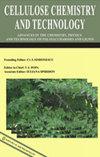从康普茶中提取细菌纤维素的酶法升级循环以获得纤维素二糖
IF 1.1
4区 农林科学
Q2 MATERIALS SCIENCE, PAPER & WOOD
Cellulose Chemistry and Technology
Pub Date : 2023-02-28
DOI:10.35812/cellulosechemtechnol.2023.57.13
引用次数: 0
摘要
“康普茶的生产会产生细菌纤维素(BC)作为副产品,通常会被丢弃。然而,BC可能是纤维二糖的来源,纤维二糖是一种具有益生元益处的双糖。在这项研究中,使用商业鸡尾酒Celluclast 1.5 L通过酶水解评估了从中型康普茶生产商收集的纤维二糖释放的纤维二碳的产量。将BC在固体含量为2%、3%和4%(m/v)、酶用量为2.2U/g纤维素、pH为5、50°C和150rpm下水解72小时。通过FTIR和XRD对工业BC进行表征,以确认存在常见的BC特性。在酶水解后进行相同的分析,导致结晶度的变化。在水解48小时内,用4%BC(w/v)获得最大纤维二糖产量(10-11g/L);当时间延长到72小时时,没有显著差异。在相同条件下,最大葡萄糖产量为3g/L,表明Celluclast 1.5L具有高的纤维二糖选择性(78%)。然而,纤维二糖的产率仅在35%至26%之间,表明纤维二糖在培养基中的积累引起了酶的抑制。“本文章由计算机程序翻译,如有差异,请以英文原文为准。
ENZYMATIC UPCYCLING OF BACTERIAL CELLULOSE FROM KOMBUCHA TO OBTAIN CELLOBIOSE
"The production of kombucha generates bacterial cellulose (BC) as a by-product, which is usually discarded. However, BC can be a source of cellobiose, a disaccharide with prebiotic benefits. In this study, the yield of cellobiose released from BC collected from a medium-sized kombucha producer was evaluated by enzymatic hydrolysis using the commercial cocktail Celluclast 1.5 L. The BC was hydrolyzed at solid contents of 2, 3 and 4% (m/v), enzyme dosage of 2.2 U/g cellulose, pH 5, 50 °C, and 150 rpm for 72 h. Industrial BC was characterized by FTIR and XRD to confirm the presence of common BC characteristics. The same analyses were performed after enzymatic hydrolysis, resulting in a change in crystallinity. The maximum cellobiose production (10-11 g/L) was obtained with 4% BC (w/v) in 48 h of hydrolysis; there was no significant difference when the time was extended to 72 h. The maximum glucose production under the same conditions was 3 g/L, showing that Celluclast 1.5 L has high cellobiose selectivity (78%). However, the cellobiose yield only ranged from 35 to 26%, indicating that cellobiose accumulation in the medium caused enzyme inhibition."
求助全文
通过发布文献求助,成功后即可免费获取论文全文。
去求助
来源期刊

Cellulose Chemistry and Technology
工程技术-材料科学:纸与木材
CiteScore
2.30
自引率
23.10%
发文量
81
审稿时长
7.3 months
期刊介绍:
Cellulose Chemistry and Technology covers the study and exploitation of the industrial applications of carbohydrate polymers in areas such as food, textiles, paper, wood, adhesives, pharmaceuticals, oil field applications and industrial chemistry.
Topics include:
• studies of structure and properties
• biological and industrial development
• analytical methods
• chemical and microbiological modifications
• interactions with other materials
 求助内容:
求助内容: 应助结果提醒方式:
应助结果提醒方式:


